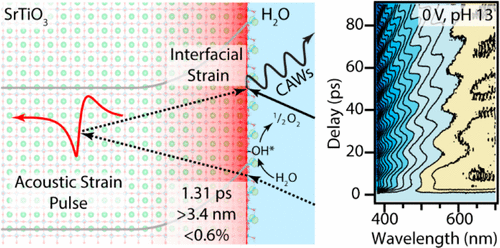当前位置:
X-MOL 学术
›
J. Am. Chem. Soc.
›
论文详情
Our official English website, www.x-mol.net, welcomes your feedback! (Note: you will need to create a separate account there.)
Coherent Acoustic Interferometry during the Photodriven Oxygen Evolution Reaction Associates Strain Fields with the Reactive Oxygen Intermediate (Ti–OH*)
Journal of the American Chemical Society ( IF 15.0 ) Pub Date : 2021-09-23 , DOI: 10.1021/jacs.1c04976 Suryansh Singh 1, 2 , Hanna Lyle 1, 2 , Luca D'Amario 3, 4 , Elena Magnano 5, 6 , Ilya Vinogradov 1 , Tanja Cuk 1, 2, 7
Journal of the American Chemical Society ( IF 15.0 ) Pub Date : 2021-09-23 , DOI: 10.1021/jacs.1c04976 Suryansh Singh 1, 2 , Hanna Lyle 1, 2 , Luca D'Amario 3, 4 , Elena Magnano 5, 6 , Ilya Vinogradov 1 , Tanja Cuk 1, 2, 7
Affiliation

|
The oxygen evolution reaction (OER) from water requires the formation of metastable, reactive oxygen intermediates to enable oxygen–oxygen bond formation. Conversely, such reactive intermediates could also structurally modify the catalyst. A descriptor for the overall catalytic activity, the first electron and proton transfer OER intermediate from water, (M–OH*), has been associated with significant distortions of the metal–oxygen bonds upon charge-trapping. Time-resolved spectroscopy of in situ, photodriven OER on transition metal oxide surfaces has characterized M–OH* for the charge trapping and the symmetry of the lattice distortions by optical and vibrational transitions, respectively, but had yet to detect an interfacial strain field arising from a surface coverage M–OH*. Here, we utilize picosecond, coherent acoustic interferometry to detect the uniaxial strain normal to the SrTiO3/aqueous interface directly caused by Ti–OH*. The spectral analysis applies a fairly general methodology for detecting a combination of the spatial extent, magnitude, and generation time of the interfacial strain through the coherent oscillations’ phase. For lightly n-doped SrTiO3, we identify the strain generation time (1.31 ps), which occurs simultaneously with Ti–OH* formation, and a tensile strain of 0.06% (upper limit 0.6%). In addition to fully characterizing this intermediate across visible, mid-infrared, and now GHz-THz probes on SrTiO3, we show that strain fields occur with the creation of some M–OH*, which modifies design strategies for tuning catalytic activity and provides insight into photo-induced degradation so prevalent for OER. To that end, the work put forth here provides a unique methodology to characterize intermediate-induced interfacial strain across OER catalysts.
中文翻译:

光驱动氧释放反应过程中的相干声干涉测量将应变场与活性氧中间体 (Ti-OH*) 相关联
水中的析氧反应 (OER) 需要形成亚稳态的活性氧中间体,以形成氧-氧键。相反,这种反应性中间体也可以在结构上改变催化剂。整体催化活性的描述,即来自水的第一个电子和质子转移 OER 中间体(M-OH*),与电荷俘获时金属-氧键的显着扭曲有关。过渡金属氧化物表面上原位光驱动 OER 的时间分辨光谱分别表征了 M-OH* 的电荷俘获和由光学和振动跃迁引起的晶格畸变的对称性,但尚未检测到产生的界面应变场来自表面覆盖率 M-OH*。在这里,我们利用皮秒,3 /由Ti-OH*直接引起的水界面。光谱分析应用了一种相当通用的方法来检测通过相干振荡相位的界面应变的空间范围、幅度和产生时间的组合。对于轻掺杂的 SrTiO 3,我们确定了应变产生时间 (1.31 ps),它与 Ti-OH* 形成同时发生,拉伸应变为 0.06%(上限 0.6%)。除了在 SrTiO 3上通过可见光、中红外和现在的 GHz-THz 探针充分表征这种中间体,我们表明应变场随着一些 M-OH* 的产生而发生,这改变了调节催化活性的设计策略,并提供了对 OER 如此普遍的光诱导降解的见解。为此,这里提出的工作提供了一种独特的方法来表征跨 OER 催化剂的中间诱导界面应变。
更新日期:2021-10-06
中文翻译:

光驱动氧释放反应过程中的相干声干涉测量将应变场与活性氧中间体 (Ti-OH*) 相关联
水中的析氧反应 (OER) 需要形成亚稳态的活性氧中间体,以形成氧-氧键。相反,这种反应性中间体也可以在结构上改变催化剂。整体催化活性的描述,即来自水的第一个电子和质子转移 OER 中间体(M-OH*),与电荷俘获时金属-氧键的显着扭曲有关。过渡金属氧化物表面上原位光驱动 OER 的时间分辨光谱分别表征了 M-OH* 的电荷俘获和由光学和振动跃迁引起的晶格畸变的对称性,但尚未检测到产生的界面应变场来自表面覆盖率 M-OH*。在这里,我们利用皮秒,3 /由Ti-OH*直接引起的水界面。光谱分析应用了一种相当通用的方法来检测通过相干振荡相位的界面应变的空间范围、幅度和产生时间的组合。对于轻掺杂的 SrTiO 3,我们确定了应变产生时间 (1.31 ps),它与 Ti-OH* 形成同时发生,拉伸应变为 0.06%(上限 0.6%)。除了在 SrTiO 3上通过可见光、中红外和现在的 GHz-THz 探针充分表征这种中间体,我们表明应变场随着一些 M-OH* 的产生而发生,这改变了调节催化活性的设计策略,并提供了对 OER 如此普遍的光诱导降解的见解。为此,这里提出的工作提供了一种独特的方法来表征跨 OER 催化剂的中间诱导界面应变。



























 京公网安备 11010802027423号
京公网安备 11010802027423号